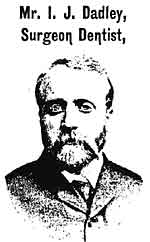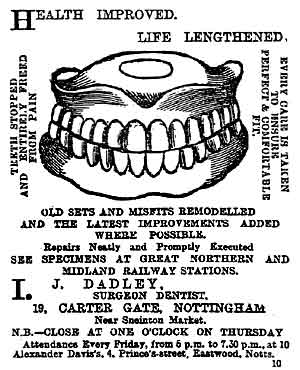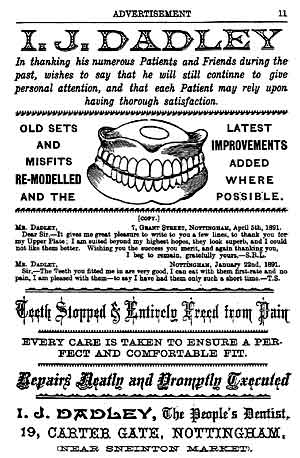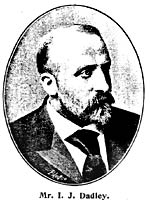< Previous
IT PAID TO ADVERTISE:
1. The People’s Dentist
By Stephen Best
 ISAAC JEFFERIES DADLEY as he appeared in 'Nottingham Illustrated' 1892 .
ISAAC JEFFERIES DADLEY as he appeared in 'Nottingham Illustrated' 1892 .OLD ADVERTISEMENTS are nearly always interesting and entertaining. From each one we can gain, not merely a glimpse of a particular business, but also a flavour of the time and place in which it flourished. Of bygone Sneinton tradespeople, comparatively few have left us much in the way of a printed advertisement to throw additional light on the goods they sold, the products they made, or the services they offered. Nevertheless, some fascinating examples do exist, and, in what is hoped may prove to be an occasional series, we shall see how some local traders used to remind the public of their existence, and invite their custom.
Some of the most arresting adverts seen in and around Sneinton a hundred years ago came from a rather surprising source.
This was Isaac Jefferies Dadley, the self- styled 'People’s Dentist' of 19-21 Carter Gate. In the late 1880s I. J. Dadley joined his father, Elijah Dadley, at these premises, and they remained next-door business neighbours there for several years, until the older man retired. Elijah had traded there since about 1866, categorising himself at various times as a botanic druggist; a chemist, druggist and botanist; or as a herbalist. The building stood at the comer of Carter Gate and Stanhope Street, on a site which is today in Lower Parliament Street, near the entrance to the Nottingham City Transport garage, and almost opposite the Ice Stadium. Nowadays an area with very few residents, the neighbourhood was in the 1880s home to some of Nottingham’s poorest people, who lived in small, dark, insanitary houses, crowded together in the area lying between Carter Gate and Manvers Street. Dadley carried on his practice here for some fifteen years, moving at the beginning of this century to much more salubrious surroundings at Market Chambers, 10 South Parade. In his home addresses, too, he was to move steadily up-market, (a phrase he certainly would never have heard). In the middle of the eighties he was living quite close to his place of work, at 24 Promenade, off Bath Street, but by 1889 had an address in London Road. The 1891 census found him at 24 Arkwright Street, with his wife and three children, the middle one a girl named Hephzibah. Also living in the family home was a 17 year-old lodger, described as ‘apprentice to dentist’. Like many of Nottingham’s professional people, Dadley had by the close of the nineteenth century moved out to the new and more fashionable residential suburb of West Bridgford. Here he lived for a number of years at ‘Burleigh Cottage’, 8 Henry Road. Much later he moved again, and for a short period after the First World War was listed in the directory as a resident of 389 Mansfield Road, Carrington, close to the comer of Church Drive. His last appearance in local trade directories, in 1922, shows him living at this address, and still practising dentistry in South Parade. For about a decade, around the time of the Great War, Dadley’s son Walter was in business in Nottingham as a manufacturer of artificial teeth.
A particularly instructive glimpse of the ‘People’s Dentist’ is afforded by ‘Nottingham Illustrated’, an advertising volume which came out about 1892. This remains one of our best sources of information on late Victorian commercial activity in Nottingham, with pictures of a number of industrial premises which are otherwise unrecorded. So fulsome, however, are the comments on every business described in the book, that one assumes that those included paid handsomely for the advertising space which the publication made available, and either wrote the copy themselves, or told the publishers exactly what they wanted written about their own enterprise. The paragraph on ‘Mr. I. J. Dadley, Surgeon Dentist’ is accompanied by a photograph of the man himself, in vigorous early middle age (he was forty at the time), with handsome full beard and moustache, while the accompanying text is rich in Victorian orotundity; ‘It may, with truth, be said, that many of the blessings of life depend on the good condition of the teeth, for, should these useful organs be in any way neglected and their functional use impaired, the effects are felt throughout the entire system. It therefore behoves all who study health and comfort to pay attention to the preservation when good, or the replacement when decayed, of these necessary aids to digestion. Improvements in dentistry have of late greatly increased the favour in which practitioners, who, like Mr. I. J. Dadley, have given up much time to the study of the art, are held; and now that modern science has so much simplified operations, and robbed them of their objectionable features, there can be no excuse for voluntary suffering that a visit to the dentist would quickly dispel. Mr. Dadley has had much experience of every class of dental practice, and may be thoroughly relied upon, not only to extract, stop, scale, or perform any operation in connection with the teeth, but as a manufacturer of artificial sets, he has long been known for the excellence of this workmanship and the moderated charges which he has adopted. Old sets and misfits by other makers may be cleverly remodelled, and rendered much more comfortable and effective, all the latest improvements being added whenever practicable. Repairing also forms a speciality, and is conducted by skilleddentists on the premises at Carter Gate. Whether it be an order for a new set, or the re-construction and alteration of old, every care is taken to ensure comfort and a good appearance, coupled with ease in mastication. Mr. Dadley attends at Mr Alexander Davis’s, 45, Princes Street, Eastwood, every Friday to see patients, the hours being from 5 to 7.30 pm - this is a great convenience to residents in that district, who are unable to visit the county town. In Nottingham itself, Mr. Dadley is well known as the 'people's dentist and conducts a large and ever-increasing practice on popular lines at popular prices. Every comfort and attention is provided for visitors to his establishment, which is situated in a central and convenient locality, close to Sneinton Market, one of the busiest quarters of the town, and near to both railway stations.’
There is much to savour here. Dadley lays heavy emphasis on the importance of dental care, advice of a kind doubtless greatly needed in 1892. In typical Victorian fashion, he endeavours to show his erudition by referring to teeth as 'necessary aids to digestion but one is less at ease with the description of them as ‘useful organs.' Veiled in flowery language is the assurance that dental treatment is less painful than it used to be, and that the 'people’s dentist' will do any necessary work at a reasonable and competitive price. One cannot help feeling, though, that implicit in the advertisement is the acceptance that most of his customers will already have lost their natural teeth, and so have to face the prospect of obtaining the best set of false gnashers they can afford. The reader is also left with the mental picture of Mr Dadley, fired with missionary zeal, gallantly venturing out to the howling wastes of Eastwood, a place otherwise unvisited by dentists, to bring relief to sufferers. The 1891 census reveals Alexander Davis, whose premises were used each week by Dadley, to have been a coal miner, so we may assume that the dentist did his work in the back kitchen or the parlour of a private house. The reference to his practice being close the railway stations is intriguing; did I. J. Dadley envisage passengers arriving in Nottingham with unbearable toothache and rushing to the haven of his surgery for instant relief, or was he hoping that new arrivals to the town, toothless, or possessors of broken dentures, would skulk shamefacedly along Station Street and London Road to Carter Gate; there to be made more presentable by his skill? The self-important fussiness and earnestness of this advertisement is worthy of Mr Potter, whose doings were, in this very same year, being chronicled in 'The Diary of a Nobody'1. Whether or not this classic was known to Mr Dadley or many of his Sneinton patients, we shall never know.
 A TYPICAL DADLEY ADVERTISEMENT; Nottingham Evening Post, October 7 1893.
A TYPICAL DADLEY ADVERTISEMENT; Nottingham Evening Post, October 7 1893.The 'People's Dentist' made his chief impact on the publicity scene, however, with the style he adopted for his newspaper advertisements. The attention of the toothache-sufferer was immediately gripped (and gripped seems to be the right word) by a spirited and gruesome depiction of a fearsome set of false teeth, grinning out from the page. The example shown here appeared in the Nottingham Evening
Post of October 7 1893, and is headed with the modest and eye-catching slogan: 'HEALTH IMPROVED. LIFE LENGTHENED'. Once again, there is mention of the local railway stations, with the added detail that specimens of Dadley's handiwork were to be seen at the Midland and London Road Stations: presumably these were on display in glass cases for the edification of the travelling public and afflicted railway employees alike. As did most local businesses of the time, the Dadley establishment observed Nottingham’s traditional early-closing day, Thursday.
 From FLEEMAN’S ANNUAL DIARY AND ALMANAC, 1894.
From FLEEMAN’S ANNUAL DIARY AND ALMANAC, 1894.An even jollier and more uninhibited Dadley advert is to be found in 'Fleeman's Nottingham Christmas Annual Diary and Almanac' for 1894. Robert Fleeman, a Nottingham town councillor, was proprietor of a hardware and fancy goods shop in Broad Marsh, and, incidentally, one of the most relentless commercial publicists ever seen in Nottingham. His printers, Howitt & Son of Clumber Street, really let themselves go when setting up the advertisement pages in the Almanac, and took pains to leave no decorative typeface out of their layouts. I. J. Dadley has a full page to himself, with his sign-manual, the set of false choppers, holding centre stage. His advert opens with a message from the dentist, in which he thanks his 'numerous patients and friends' and assures them of his continued personal attention in the future. Reinforcing the dentist's claims are a couple of letters from satisfied customers, both bearing testimony to the excellence of the false teeth supplied by him. T. S. writes: 'The teeth you fitted me in are very good. I can eat in them first- rate and no pain' S. R. L. of Grant Street, Radford, gifted with a more graceful epistolary style, tells him: 'I am suited beyond my highest hopes, they look superb.... ’ (It has, regrettably, proved impossible to discover anything at all about S. R. L.) . There is, sadly, no testimonial describing how Dadley has saved its writer’s own natural teeth from decay and extraction. In making sure that all of Mr Dadley’s many virtues are mentioned in the advertisement, the printer has, as already observed, succeeded in employing a wonderful variety of types. It is a pity that comparable zeal has not gone into the proof-reading, however; there is a real howler in the spelling of the opening sentence, and in setting up the fancy type of the word ‘executed’, the compositor has used a capital ‘T'; instead of the ‘E’ required.
 Mr. I. J. Dadley, THE PEOPLE'S DENTIST' at the turn of the century, as pictured in 'Contemporary Biographies' 1901.
Mr. I. J. Dadley, THE PEOPLE'S DENTIST' at the turn of the century, as pictured in 'Contemporary Biographies' 1901.A final glimpse of I. J. Dadley, just before he moved his premises from Carter Gate, may be found in a large and impressive volume published in 1901; this is ‘Contemporary Biographies: Nottinghamshire and Derbyshire at the opening of the Twentieth Century’. It contains photographs of several hundred notables of the two counties at that date, but has some puzzling features. Though a number of members of the nobility and top professional classes appear, others do not, and we may assume that the missing men (yes, only men are included) declined to respond to the invitation to send in details and a portrait. There is, one has to say, an obvious unevenness in a book of this sort which has not mention of, say, the headmaster of Nottingham High School, but which includes I. J. Dadley. Our hero has a place in the 'Dental' section, his portrait providing evidence that almost a decade has passed since his appearance in ‘Nottingham Illustrated’; now on the verge of fifty, his hair is, perhaps, thinner, though his beard and moustache are as impressive as before. It comes as no great surprise, after reading his advertisements of the 1890s, to find that the 'People’s Dentist' is the only one of the eleven dental practitioners in Nottinghamshire and Derbyshire included here who makes no mention of any formal training or professional qualifications. Born in Derby, he was educated in Nottingham and, it seems likely, learned his craft as an apprentice at the elbow of an unqualified tooth-drawer. Might this instructor have been his father Elijah Dadley? Many chemists of his day found a ready clientele for dental skills, so the possibility cannot be ruled out.
Here we take our leave of Isaac Jefferies Dadley as he prepares to forsake shabby Carter Gate for a much grander address in South Parade. His perky, yet self- important, style of publicity makes him easy to poke fun at, as I admit to having done here. He does, however deserve an honourable, if minor, place in Sneinton history, as a man who, over many years, made life more tolerable for local people by delivering them from the miseries of toothache.
1 The Diary of a Nobody, by George and Weedon Grossmith
< Previous
